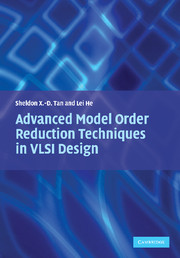Book contents
- Frontmatter
- Contents
- Figures
- Tables
- Foreword
- Acknowledgments
- 1 Introduction
- 2 Projection-based model order reduction algorithms
- 3 Truncated balanced realization methods for MOR
- 4 Passive balanced truncation of linear systems in descriptor form
- 5 Passive hierarchical model order reduction
- 6 Terminal reduction of linear dynamic circuits
- 7 Vector-potential equivalent circuit for inductance modeling
- 8 Structure-preserving model order reduction
- 9 Block structure-preserving reduction for RLCK circuits
- 10 Model optimization and passivity enforcement
- 11 General multi-port circuit realization
- 12 Reduction for multi-terminal interconnect circuits
- 13 Passive modeling by signal waveform shaping
- References
- Index
3 - Truncated balanced realization methods for MOR
Published online by Cambridge University Press: 19 January 2010
- Frontmatter
- Contents
- Figures
- Tables
- Foreword
- Acknowledgments
- 1 Introduction
- 2 Projection-based model order reduction algorithms
- 3 Truncated balanced realization methods for MOR
- 4 Passive balanced truncation of linear systems in descriptor form
- 5 Passive hierarchical model order reduction
- 6 Terminal reduction of linear dynamic circuits
- 7 Vector-potential equivalent circuit for inductance modeling
- 8 Structure-preserving model order reduction
- 9 Block structure-preserving reduction for RLCK circuits
- 10 Model optimization and passivity enforcement
- 11 General multi-port circuit realization
- 12 Reduction for multi-terminal interconnect circuits
- 13 Passive modeling by signal waveform shaping
- References
- Index
Summary
Introduction
Model order reduction methods for linear and non-linear dynamic systems in general can be classified into two categories [6]:
Singular-value-decomposition (SVD) based approaches
Krylov-subspace-based approaches.
Krylov-subspace-based methods have been reviewed in Chapter 2. In this chapter, we focus on the SVD-based reduction methods. Singular value decomposition is based on the lower rank approximation, which is optimal in the 2-norm sense. The quantities for deciding how a given system can be approximated by a lower-rank system are called singular values, which are the square roots of the eigenvalues of the product of the system matrix and its adjoint. The major advantage of SVD-based approaches over Krylov subspace methods lies in their ability to ensure the errors satisfying an a-priori upper bound. Also, SVD-based methods typically lead to optimal or near optimal reduction results as the errors are controlled in a global way. However, SVD-based methods suffer the scalability issue as SVD is a computational intensive process and cannot deal with very large dynamic systems in general. In contrast, Krylov-subspace-based methods can scale to reduce vary large systems due to efficient computation methods for moment vectors and their orthogonal forms.
SVD-based approaches consist of several reduction methods [6]. In this chapter, we mainly focus on the truncated-balanced-realization (TBR) approach and its variants, which were first introduced by Moore [81].
- Type
- Chapter
- Information
- Advanced Model Order Reduction Techniques in VLSI Design , pp. 37 - 55Publisher: Cambridge University PressPrint publication year: 2007



